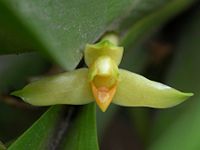Heterotaxis
| Heterotaxis | ||||||||||||||||||||
|---|---|---|---|---|---|---|---|---|---|---|---|---|---|---|---|---|---|---|---|---|
 Heterotaxis sessilis
| ||||||||||||||||||||
| Scientific classification | ||||||||||||||||||||
| ||||||||||||||||||||
| Type species | ||||||||||||||||||||
| Heterotaxis crassifolia Lindl. 1826 | ||||||||||||||||||||
| Species | ||||||||||||||||||||
| ||||||||||||||||||||
| Synonym | ||||||||||||||||||||
Heterotaxis is a genus of orchids formed by a group of circa fourteen neotropical species which previously were considered part of genus Maxillaria. They are strong epiphytic plants with shiny dark green leaves which make a showy display making a very good first impression but end disappointing because of their small flowers, usually yellow, which, because of their short inflorescences, hide between the foliage and can hardly be seen. Although the species that belong to this genus are easy to identify, because they vary a lot and are much similar to each other, to diferentiate them is hard, with very few exceptions.
Distribution
The range of distribution of Heretotaxis is wide, particularly because of the type species, H. sessilis, which can be found from South Florida, Caribbean and Mexico, spread through all Central America countries to tropical America, reaching Bolivia and South Brazil.
All species are mostly epiphytic, despite some hardly ever can be seen living as litophytes on shady and humid cliffs. The species of Heterotaxis hardly ever are found living under full sunlight, being more common under the shelter and shade of trees. They are strong plants that can adapt to diferent environment conditions, since very wet forests of Florida and Amazon, to cloud mountain forests in the Andes and along Serra do Mar mountains in Brazil, and even in dry jungles of highlands of Central Brazil. Some species, like Heterotaxis equitans can be found also living at the edges of the jungles were the get more light than most of other species of this genus.
Description
Heterotaxis are comparatively large and robust plants, usually of sympodial growth, with unifoliate lateraly compressed pseudobulbs, protected by several foliar stealths of almost always glossy foliage; or they can also lack pseudobulbs and have distical leaves, then growing simulating monopodial growth. All species have small thick flowers, which frequently do not open interely, ordinaryly yellowish, but also orange or white, sometimes with purple-bluish, lilac or brown-red spots. A thickening on the center of the lip is also common, sometimes it is covered by waxy trichomes that atract pollinators. Their column is very short. As all species once subordinated to Maxillaria the inflorescences are lateral and bear just one flower, and here are long, short or very short, in small numbers, ordinarily blooming more than once a year.
Taxonomic notes
John Lindley proposed this genus in 1826, when he described Heterotaxis crassifolia, its type species. Four years later, he described another new genus and species, Dicrypta baueri, which is today considered a synonym of the former. Within a few years, contemporary and subsequent taxonomists described or transfered all known species to Dicrypta. During the decade of 1850, Heinrich Gustav Reichenbach decided that there was no reason enough to maintain these species separated and moved them all to Maxillaria.
In 1947 the Brazilian Botanist Frederico Carlos Hoehne suggested a new genus, Marsupiaria, to subordinate the species lacking pseudobulbs. Later taxonomists, such as Garay, Senghas e Pabst, followed Hoehne and, one by one, along the years, subordinated all species of this group today known to Hoehne's genus.
Finally, Fábio de Barros published a review in 2002 restablishing the ancient genus Heterotaxis, the first proposed by Lindley. Both modern phylogeny and recent descriptions agree with the acceptance of this genus but, so far, nurseries and growers still use their former names and old synonymes, mostly Marsupiaria e Maxillaria.
References
- R. Govaerts, M.A. Campacci (Brazil, 2005), D. Holland Baptista (Brazil, 2005), P.Cribb (K, 2003), Alex George (K, 2003), K.Kreuz (2004, Europe), J.Wood (K, 2003, Europe); World Checklist of Orchidaceae. The Board of Trustees of the Royal Botanic Gardens, Kew. Published on the Internet accessed February 2009.
- Isidro Ojeda, Germán Carnevali Fernández-Concha & Gustavo A. Romero-González; New Species and Combinations in Heterotaxis Lindley (Orchidaceae: Maxillariinae) - Novon: A Journal for Botanical Nomenclature, Volume 15, Issue 4, pp. 572–582 (December 2005).
- Blanco, M. A. G. Carnevali, W. M. Whitten, R. Singer, S. Koehler, N. H. Williams, I. Ojeda, K. Neubig, & L. Endara. 2007. Generic Realignments in Maxillariinae (Orchidaceae). Lankesteriana 7(3): 515-537.
- Whitten, W.M., M. A. Blanco, N. H. Williams, S. Koehler, G. Carnevali, R. B. Singer, L. Endara, & K. M. Neubig. 2007. Molecular Phylogenetics of Maxillaria and Related Genera (Orchidaceae: Cymbidieae) Based Upon Combined Molecular Data Sets. American Journal of Botany 94: 1860-1889.
- Fábio de Barros, Notas taxonômicas para espécies brasileiras dos gêneros Epidendrum e Heterotaxis (Orchidaceae), Hoehnea 29: 112 (2002).